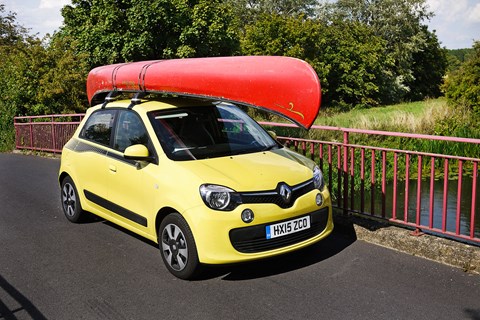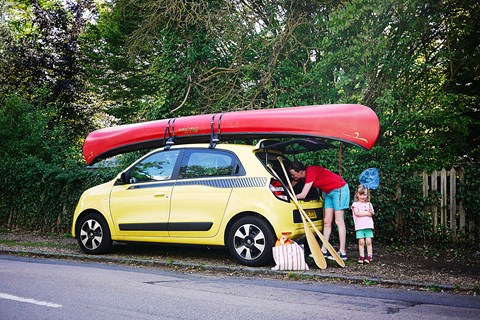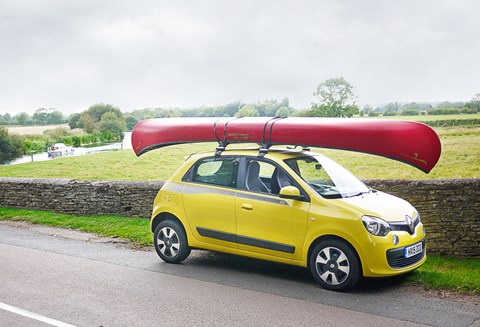► Month six with our Renault Twingo
► It’s adventure time, to the river!
► We put a canoe on a Twingo
It played havoc with the aerodynamics. It felt like I’d attached a sail to the roof, or a parachute; as if at any moment it might lift the car like an empty plastic bag in a breeze, and swirl it into the air to get tangled in a streetlight. Directional stability was also affected, the steering wheel jinking left and right as the crosswinds grabbed a hold of us, like a toy car with a handle on the roof. I can see why Renault doesn’t offer a five-metre Canadian canoe as an option on the Twingo.
However, they do offer roof bars! True, the roof in question is as big as a hand towel, but just because it’s small doesn’t mean the titchy Renault can’t go on big, round-the-world adventures. Imagine: a glovebox full of exotic maps; the roof loaded high with camping equipment like an old Land Rover on safari; and the little three-cylinder engine groaning and wheezing with the effort. The Himalayas would be an entirely first-gear affair, but the Gobi Desert would be a piece of cake.
Sadly, without a six-month window in my diary and with half the world in some kind of horrific civil war, I couldn’t go on a round-the-world trip this time; but those roof bars kept staring at me in the Twingo brochure, whispering ‘Use me! Uuuusssse meeeeeee!’ So I decided to do what I always do whenever civilisation is threatened, society is crumbling and the world is sliding into geo-political disaster: I bugger off on my boat.

I’ve owned this canoe for over a decade now, and it comes out regularly each summer. It’s a five-metre-long Old Town Charles River, made out of a material called ‘Royalex’, which feels like washing-up-bowl plastic but is actually a fancy composite devised by UniRoyal in the 1960s. Light and strong and capable of recovering from dents, it was used in a Ford concept car in 1965, the pretty ‘Bordinat Cobra’. But it proved too expensive for big items, so it’s been mainly used for canoe hulls ever since – though I hear Royalex production has ceased now, because of the low volumes. Shame. When this one breaks, my next boat will have to be made of real washing-up bowl plastic… made from real washing-up bowls.
Anyway, the Renault roof bars cost £112 and they’re unlike any bars I’ve ever fitted before. They wrap around the roof and grip inside the door frame with the help of small pins, which locate in four corresponding holes (holes you’ll find in all Twingos, if you open the doors and look). Once tightened, the bars bear the cargo on big pads that sit on the edges of the roof – the instructions say they’re rated at 60kg total (including the aluminium bars). Bizarrely, the bars interfere with the door seals, making the rubber curl up at the tops of each door. These bars are definitely a temporary, get-the-job-done-and-then-take-them-off-again attachment – I imagine the doors would leak in a downpour. The bars also look ridiculous with nothing on them. Around 80cm across and just 70cm apart, they make the car look even more like a yellow shopping trolley, now with rails to push; but with the boat loaded up and strapped down, I thought the car looked truly magnificent. The Twingo is only 3.6 metres long, almost 1.5 metres shorter than its new, bright red accessory, but I thought it carried it off with a graceful pride.
I’ve been on some long river adventures in the canoe, including paddling from Lincolnshire all the way to the Wash a few years ago; but this weekend it would be a short day-trip down a local river. So we headed for the water, and straight away the canoe on the roof made itself known. Apart from the rustling wind noise, and the feeling like the car might take off at any moment, there was also a marked dulling effect on the performance. With a kerbweight of just 865kg and a torque curve like a felled tree, the normally aspirated Twingo SCe 70 is the sort of car that’s very susceptible to weight changes. Empty the door pockets of sweet wrappers and you’ll feel it perk up; drive it after eating a full English breakfast and you’re buggered. So a 28kg canoe on the roof, plus the bars, the paddles, the picnic and the three of us, was bound to dent the already un-blistering 0-62mph time of almost 15 seconds.

Oh, and the turning circle. It also affected the turning circle. Because… well, look at it.
But we reached our river at a leisurely pace with no scary U-turns, and we had a wonderful day. If there’s one thing that can be said for the Twingo, it is a ‘feel good’ car. While it was conceived as a humdrum city car, it manages to rise above its boring domestic duties with a dose of cheeky charm. It’s got character, and I like that. The roof bars – and a canoe on the roof – can’t help but widen its appeal. And lengthen it quite a lot too.
Logbook: Renault Twingo Play SCE 70
Engine: 999cc 12v 3-cyl, 69bhp @ 6000rpm, 67lb ft @ 2850rpm
Gearbox: 5-speed manual, rear-wheel drive
Stats: 14.5sec 0-62mph, 94mph, 105g/km
Price: £9995
As tested: £10,585
Miles this month: 649
Total miles: 4447
Our mpg: 38.4
Official mpg: 62.8
Fuel this month: £82.36
Extra costs: £0
